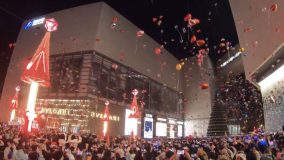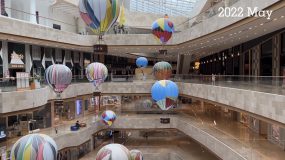Title: Control city — Malls in the post-epidemic era
City: Nanjing, Xinjiekou
Site: Mall
Directed by: Joran Zhang
A study of the impact of the epidemic and anti-epidemic measures on people’s consumption behaviour and how shopping malls are defined in the city by photographing the flow of people in malls before and after urban controls.
The significance of the mall’s presence in the city
As an urban complex, Deji Plaza brings vitality to the city and at the same time promotes the reuse of urban stock space. With a total gross floor area of approximately 250,000 square metres and a tower height of 326 metres, Deji Plaza will be a landmark building in the core area of Nanjing’s Xinjiekou upon completion, and has become a benchmark building for domestic urban complexes with its long-standing record of being one of the top three in the country in terms of single-store sales.As a new form of commercial space, Deji Plaza integrates a grand architectural space, rich consumer content, complex and convenient transportation system, diverse consumer population and urban culture into one, expanding a wider commercial space and providing more consumer experiences, thus further enhancing the charm of urban commerce.
From the perspective of the shopping population, people’s consumption and shopping nowadays are no longer satisfied with shopping itself, but increasingly focus on the shopping experience of the commercial environment they are in. The value of Deji Plaza fundamentally lies in its special functional complex, which establishes an interdependent value relationship with Nanjing’s Xinjiekou business circle through a reasonable urban transport connection. This enables it to adapt to the diverse life of the city.
The impact of the epidemic on the economy in shopping malls
Xinjiekou was chosen as the target because it is the largest and most representative shopping district in Nanjing. At the beginning of the video I quote an overhead video with subtitles to illustrate the value of the district and its significance to the city.
In the video I have filmed the public areas outside the mall to demonstrate that Deji Plaza is not only an indoor shopping centre, but it also offers a large outdoor area for socialising.
The video consists of three parts in total, in the first stage I introduce the basic information about the target of the shoot. The second stage is to control the events held in that mall before and the traffic that attended. The third stage is the mall that has recently been unblocked in Nanjing but is still cold.
In the video, I made a comparison by filming hot air balloons indoors in a shopping mall and balloons being released freely on New Year’s Eve, trying to use controlled balloons and free flying balloons as a metaphor for the people controlled by the anti-epidemic policy.
I also made adjustments in terms of colour, with the pre-control footage being warm in tone and the post-control footage being cooler. I wanted to differentiate the mood of the film in this way.



Since the outbreak, shopping centres have been hit hard by the economic and social impact of the epidemic. Not only because consumers in the control are unable to go out and shop, but also because of the loss of income and low consumer desire. Although there are no diagnosed cases in Nanjing today and there are no excessive controls on crowd travel, the popularity of the mall is still not comparable to what it was before.
Despite shopping malls are beginning to recover, there has been a significant drop in the popularity and willingness to spend indices for shopping centres. Consumers are also spending less time in shopping centres than before. In the post-epidemic era, consumers will return gradually, but the long experience of epidemic prevention and control will cause major changes in consumers’ lifestyles, behavioural habits and consumption concepts.
What can be done to effectively stimulate consumption and raise consumer expectations? A recent research report released by Guotai Junan Securities Research concluded that short-term wage boosts are more effective than issuing consumption rolls. The more severely income damaged people are, the more pessimistic they are about future income recovery. Reversing the income expectations of those with severely damaged incomes is crucial to boosting consumption; wage increases have the most direct impact on consumer spending, and both an increase in income and a recovery in willingness to consume will lead to economic growth.
Transformation of shopping malls in the post-epidemic era
The epidemic has now recurred several times and residents are often ‘trapped’ in their communities in the post-epidemic era. In this situation, people’s needs are limited in various ways. The spread of the New Coronavirus in various forms from person to person has led to a certain fear of indoor public spaces. This fear can cause anxiety, which can be detrimental to indoor activities.
The public health crisis represented by the epidemic has placed greater demands on the design of the physical space of shopping centres, which in the post-epidemic era needs to provide people with safer and healthier commercial spaces that meet their consumption needs. The first is to consider the privacy of the commercial space. In order to meet people’s desire to consume in a less crowded environment, shopping centres can develop private cinemas, mini-cafes and personal libraries for leisure and entertainment, and set up more screens in food and beverage spaces, avoiding the proximity of dining tables to the passages frequented by people in the flow of people. The second is to focus on the outdoor aspect of the commercial space. The traditional enclosed shopping centre needs to have an open commercial area so that the whole commercial space can be integrated with the open space. Open commercial areas are the best vehicle for shopping centres to meet people’s demand for a better ventilation environment, and to give consumers more leisure experience, giving them a reason to “shop with confidence and peace of mind”.
Word count: 795
References:
- Lan Jian. Urban Complex – Nanjing Deji Plaza Architectural Design [J]. Architecture and Culture, 2020,(09):12-19.
Abstract:<正>The urban complex, also known as “HOPSCA” (abbreviation of six major business forms), namely H(Hotel), O(Office), P(Parking), S(Shoppingmall), C(Convention), and A(Apartment). The urban complex is a combination of more than three kinds of urban activity spaces such as commercial, office, flat, hotel, exhibition and parking spaces in the city,
- BGM: Kontor New Media Music. Pool Music & Media GmbH
- Overhead video of Xinjiekou: BV1mb4y1y7fU
- 2021 December Deji Plaza Video: BV1DF411B7oP BV1ny4y1e7Kz
- 开放式商业社区综合体——以南京江宁龙湖天街为例[J]. 陈跃伍. 四川建筑. 2021(02)
- Jiang Chuan. How to crack the low consumer appetite in the post-epidemic era[J]. Zhongguancun,2022,(03):34-35.
- 刘明星,盛小丰.后疫情时代购物中心发展策略研究[J].现代商业,2021,(15):26-28.
- Guotai Junan Securities Research Report, 2022,(12):3-4.
- 罗淑勇,李香楠.后疫情时代社区文化消费空间设计研究[J].大众文艺,2022,(06):28-30.
- Zhang Mengmeng. Reflections on the development of physical retailing in the post-epidemic era[J]. Modern Business, 2022,(09):21-23.
- Che Jie, Duan Loyal. Research on the design of indoor public space in university dormitory buildings in the post-epidemic era[J]. Chinese and foreign architecture, 2021,(08):121-124.
- Xie Jing,Lu Zhiyuan. Technology-enabled digital transformation of shopping malls in the post-epidemic era[J]. Intelligent Building and Smart City,2021,(07):90-91.
Name: Joran Zhang
UID: 3035836070
The video shows the epidemic’s impact on the mall by filming the same scene before and after the control, but with a sharp drop in visitors. Both the video and the essay illustrate the role of shopping malls in the city and provide a study and analysis of the development of shopping malls in the post-epidemic era.
The use of high and low angles is this technique to show the bigger picture of the mall. The change in tone before and after also does an excellent job of showing the epidemic’s impact.
While you mentioned that your research question is about the influence of the pandemic on how the mall is experienced, it appears that you have also considered non-pandemic related factors as well as changing mall designs. Perhaps, a deeper investigation into the spatiality of the urban mall complex (given your choice of Xinjiekou) and how it differs from previous design of shopping spaces could be interesting. I appreciate the intentional visual design, although some aspects were not as clear in the video at first glance. For example, maybe the contrasting scenes could be placed side-by-side or right after the other. You should also include in-text citations so that it is clearer how your references inform your analysis.